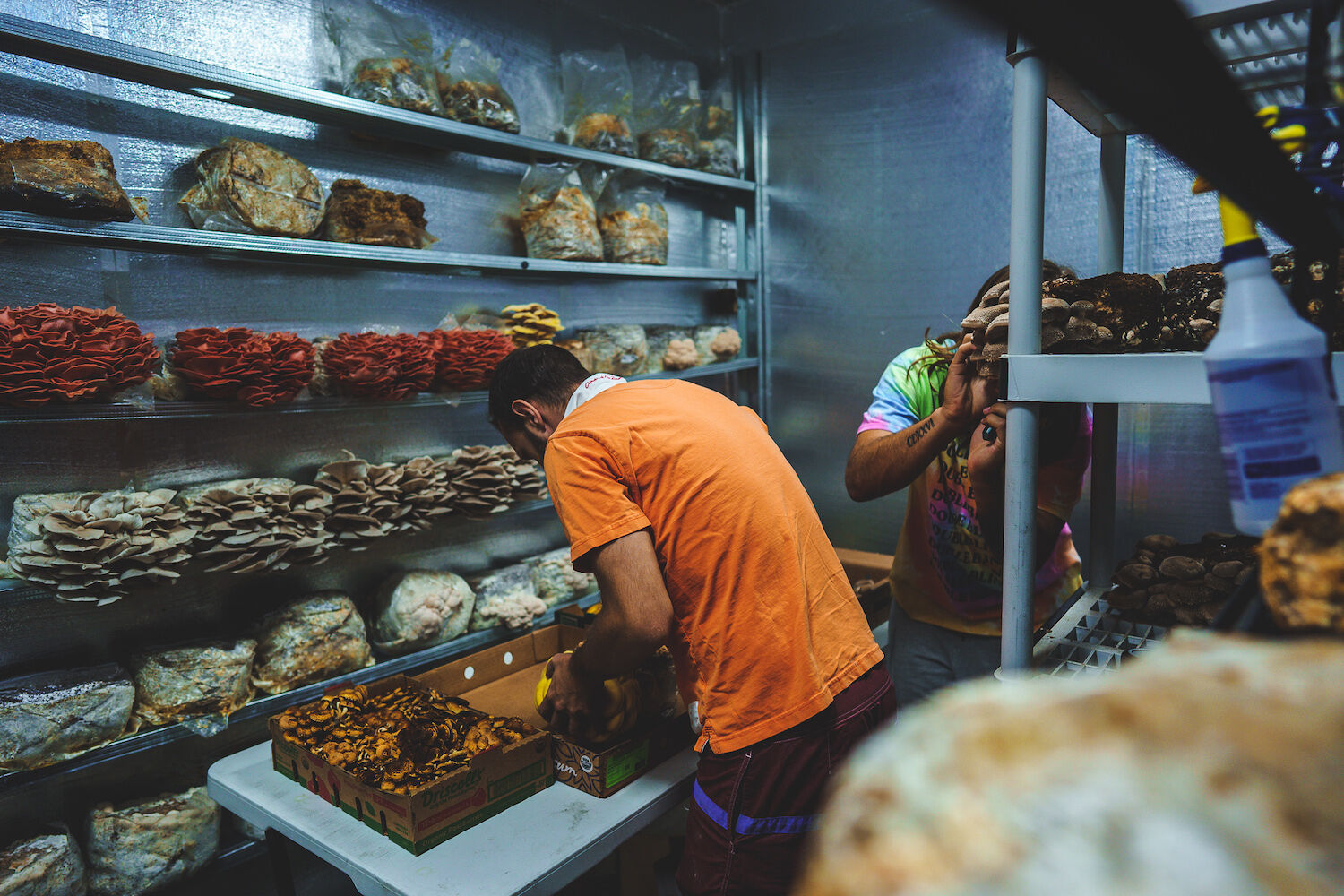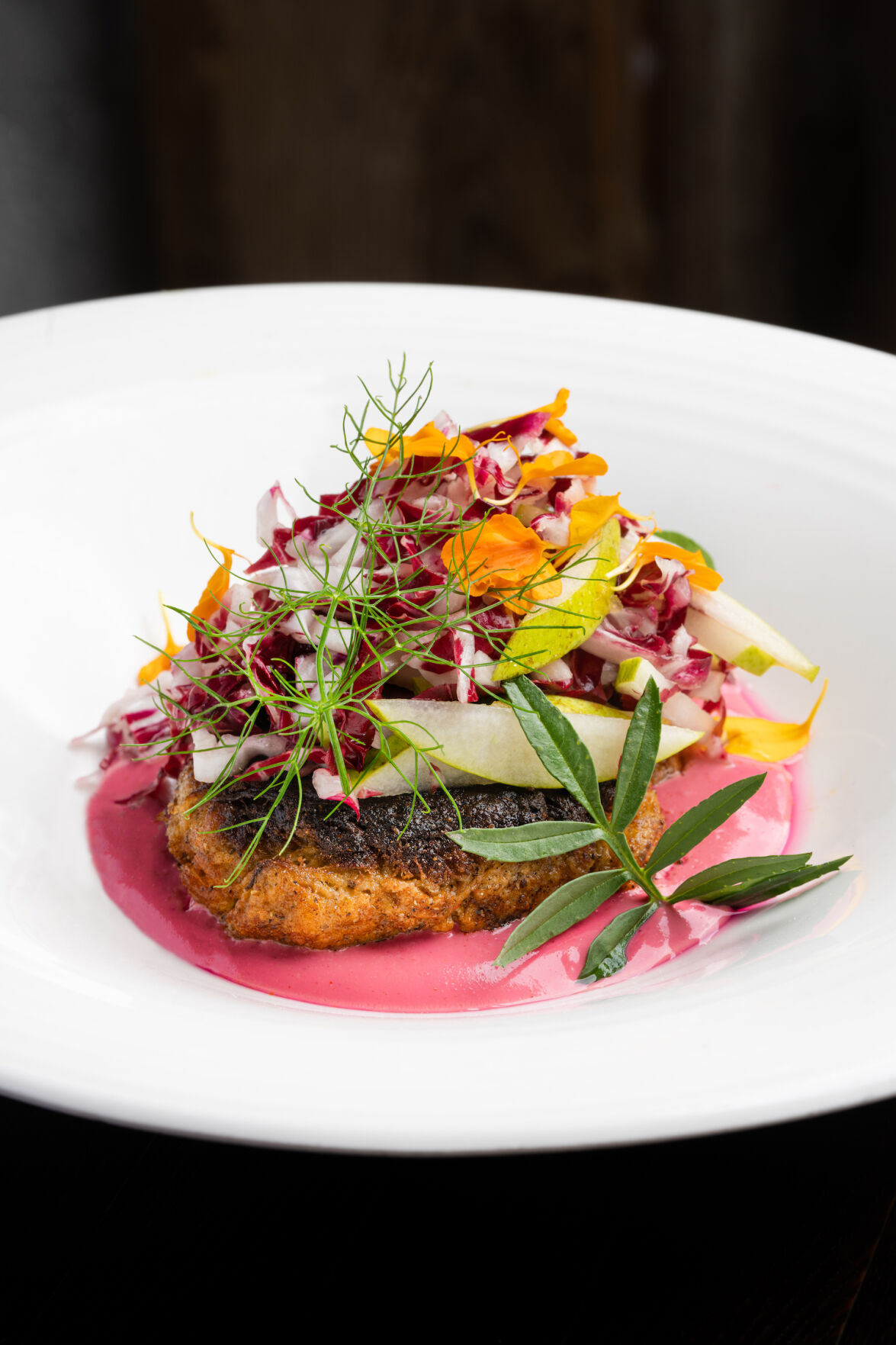
Golden Mushrooms
Courtesy of Golden Mushrooms
Fish tacos, craft beer, lion’s mane mushrooms? I’ve never really thought of San Diego as a fungus town, but it might be time to start. Our county now boasts some half a dozen mushroom growing operations, including two of the foremost shitake producers on the west coast.
However, we can credit a growing clutch of homegrown cultivators for the expanded range of specialty mushrooms turning up on local restaurant menus. Producers like Mountain Meadow Mushrooms, Mindful Mushrooms, and O.B.’s Golden Mushrooms have also been stocking farmers markets with such intriguing selections as pink oysters, king trumpets, and golden enokis.
Yet one particular type has emerged as the city’s unlikely favorite: the lion’s mane.
Forever, it’s been the province of Chinese herb shops, which sell dried lion’s mane to be brewed into medicinal teas, for a wide variety of ailments. More recently, it’s taken off in powdered and capsule form, touted by health food stores as a supplement to improve mental focus and reduce anxiety.
But only fresh can we appreciate the exquisite shagginess of the lion’s mane. Rather than the classic toadstool shape, it grows in rounded, white- or golden-haired poufs, which has earned the shroom a host of descriptive names including monkey head mushroom, pompom mushroom, and bearded hedgehog. Whatever you call it, there’s no question it’s seeing a rise in culinary demand.
Just look at Escondido’s Mountain Meadows. Established in 1952, the farm spent decades growing white button mushrooms, by far America’s most popular. Used in stir-fries and as a pizza topping, an estimated 90 percent of all mushrooms consumed in the U.S. are white buttons, and until a few years ago, Mountain Meadows sold around six million pounds a year to national distributors.
However, Roberto Ramirez, who’s been with the farm since 1996 and became majority owner in 2018, says the white button business grew unsustainable as large producers in Canada and Pennsylvania can sell them at a cheaper price than California growers. As the pandemic hit, he explains, “We had to revamp our business model, and we started growing about 18 different varieties,” that could sell for a higher price than button caps, including both medicinal and culinary types.
Lion’s mane counts as both, and Ramirez reports it is now farm’s best seller, both as a fresh mushroom selling for $15 per pound, and sold as an herbal extract selling for $20 a bottle. “It’s our number one seller because of the versatility,” he suggests, noting it’s asked for by name by local farmers market customers.
Local producers who had already been evangelizing lion’s mane at farmers markets include Om Mushroom Superfoods, a Carlsbad grower that offers powders and extracts, often brewed into beverages; and Spring Valley’s Mindful Mushrooms, an indoor, organic cultivator that’s been offering lion’s mane since it launched in 2018.
“It’s definitely one of our more popular mushrooms,” says Mindful founder Ivo Fedak, who likewise sells it in powdered form, as a food or drink additive. But Mindful has also made headway marketing lion’s mane directly to local chefs. “It can be made into some really interesting dishes,” he notes.
For farmers market buyers, this is where it helps to follow the example of local chefs. Because lion’s manes don’t resemble most edible mushrooms, it can be a challenge to know how to cook with them.
At East Village taco shop Lola 55, they’ve pulled Mindful’s lion’s mane and smoked it on a wood-fired grill for vegan taco specials. At Oceanside’s zero-waste vegan restaurant The Plot, they’re shredded and formed into faux crab cakes. That appears to be the most common use for lion’s mane, as the mushroom is reputed to have a crab-like flavor.
Enclave Café chef Lan “Lando” Thai isn’t entirely sure about that. “Honestly, I hate the taste,” she says, “It’s the most disgusting mushroom!” Nevertheless, she’s been a local champion of fresh lion’s mane, advocating its use to other chefs since she first found it available from Mindful Mushrooms. “I was shocked,” says the Vietnamese American chef, who grew up in a family that follows Eastern medicine. “I’d never really seen it outside an herb shop.”

Lion’s Mane faux crab cakes at The Plot
Credit: James Tran
She’s embraced the protein-rich mushroom as part of her food-as-medicine philosophy, which aims to return nutritional density to the meals we eat, often involving microgreens and other high-quality, locally sourced ingredients. Enclave started out as a food counter within the tasting room of the hard kombucha brewer Juneshine, but Thai recently opened a full café in University City, where lion’s mane appears in daily specials.
She’s also launched a new line of prepackaged meals, called FAMMá, which feature lion’s mane as a pulled pork substitute. And though she questions its crab-like flavor, Thai does embrace the healthful mushroom’s crab-like texture, and also bakes the lion’s mane into what she dubs, “brain cakes.”
Chef Lando says when it comes to lion’s mane, the fresher the better. She blanches the fungus before shredding it for pulled pork dishes, and squeezes it to drain excess moisture either way—though this becomes less necessary when it’s fresh and crisp. She typically roasts it at a low heat, around 300 degrees.
The key to making it delicious, she says, is deft use of seasoning to overcome its natural bitterness. She uses paprika for the crab cakes, a blend of ancho and guajillo chili peppers for the pulled pork. She’s also found a marvelous use for lion’s mane powder: as an umami-rich MSG substitute, adding it to her fried chicken recipe.
That’s a tip that will work wherever you live. But when it comes to cooking with fresh lion’s mane, consider that another benefit to living in San Diego. Because, for organisms that grow on decaying matter, fresh mushrooms don’t keep or ship especially well themselves, and most cities don’t have a choice of local growers. As Chef Thai says, “You’re not going to get this amazing lion’s mane everywhere.”



















